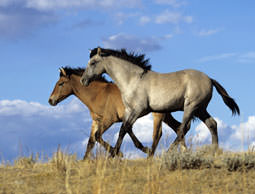
 Courtesy Tom Brakefield/Stockbyte /Thinkstock Take care with an adopted feral Mustang’s hooves, as the horse is likely not used to your farm’s environment and terrain. |
If adopting a feral Mustang from the Bureau of Land Management, there are many things you will have to keep in mind during the training process. Among them, hoof care is especially important. All adopted Mustangs need hoof trimming and, in some cases, shoeing, depending on their use and the terrain.
In a four-year study conducted on Australia’s wild horses by the Australian Brumby Research Unit within the School of Veterinary Science at the University of Queensland, Dr. Brian Hampson determined six different environments of weather and ground condition in the country. The researchers captured brumbies (the wild horses) and moved them to different locations—some wet, some dry and so on. Some of the horses’ feet didn’t hold up well. This was especially true with horses moving from the wet environment to the dry environment, which proves that when you take a horse out of its natural environment, there are going to be changes in its hooves. So when we take feral horses out of their environment and put them in a man-made environment, we have to provide man-made solutions.
![]() In the wild, horses move around on arid and abrasive ground and wear down their hooves as they go. If you put them in a paddock, they lose this opportunity completely. When you make horses domestic, domestic-horse rules apply.
In the wild, horses move around on arid and abrasive ground and wear down their hooves as they go. If you put them in a paddock, they lose this opportunity completely. When you make horses domestic, domestic-horse rules apply.
As a side note, Mustangs can have genetically bad hooves, too. Some of the horses have hoof structures that are badly shaped; they may live in the wild, but they certainly aren’t thriving. In the Australian study, some of the horses’ feet (before they were moved to a new location) were completely beaten up.
Domesticated Mustangs can also have issues stemming from improper nutrition. Mustangs survive on little sustenance in the wild, but when domesticated, they eat good food and often overeat, leading to a high number of overweight horses, horses with quick-growing hooves and horses with laminitis, a serious hoof condition. Find a good farrier, and speak to your veterinarian about a proper nutrition plan for your Mustang.
Because you have a feral horse, you’ll have to train your horse to accept hoof care. Teach it barn and shoeing manners. If you don’t have experience with a feral horse, seek assistance from someone who does.
—Steve Kraus, head of farrier services at Cornell University Hospital for Animals in Ithaca, N.Y.
This article originally appeared in the September/October 2011 issue of Hobby Farms.
About the Authors: Sharon Biggs Waller is an award-winning writer and author of Advanced English Riding (BowTie Press, 2007). She lives on a 10-acre hobby farm in northwest Indiana with her husband, Mark, 75 chickens, two Lamancha goats, two horses, and an assortment of cats and dogs. Dr. Lyle G. McNeal is a livestock specialist in the Department of Animal, Dairy and Veterinary Sciences at Utah State University.




